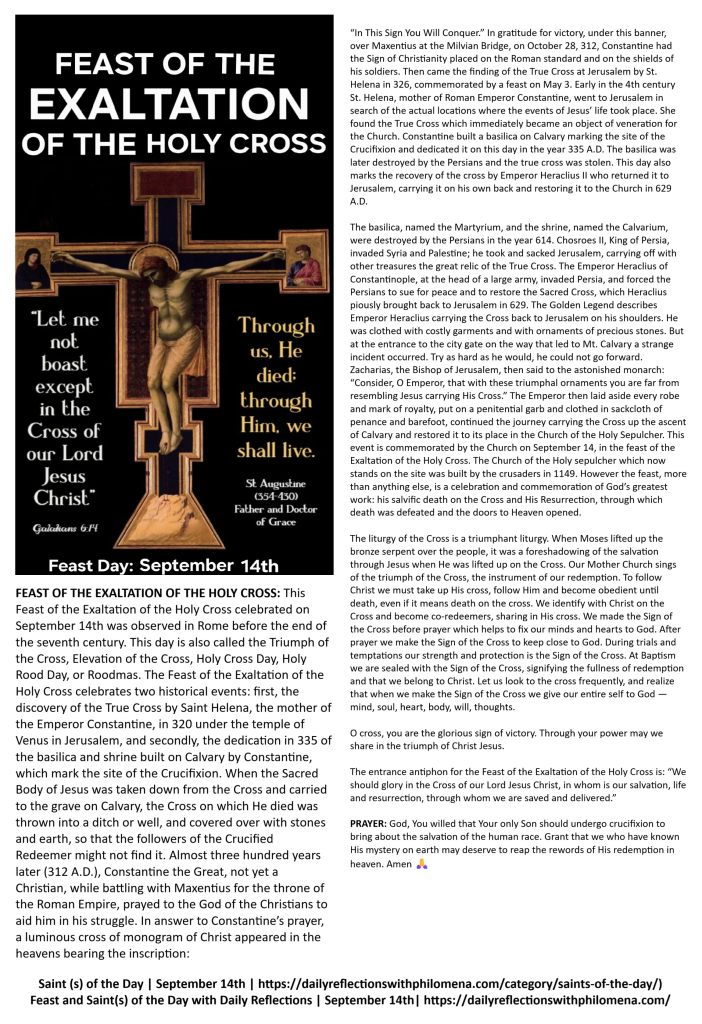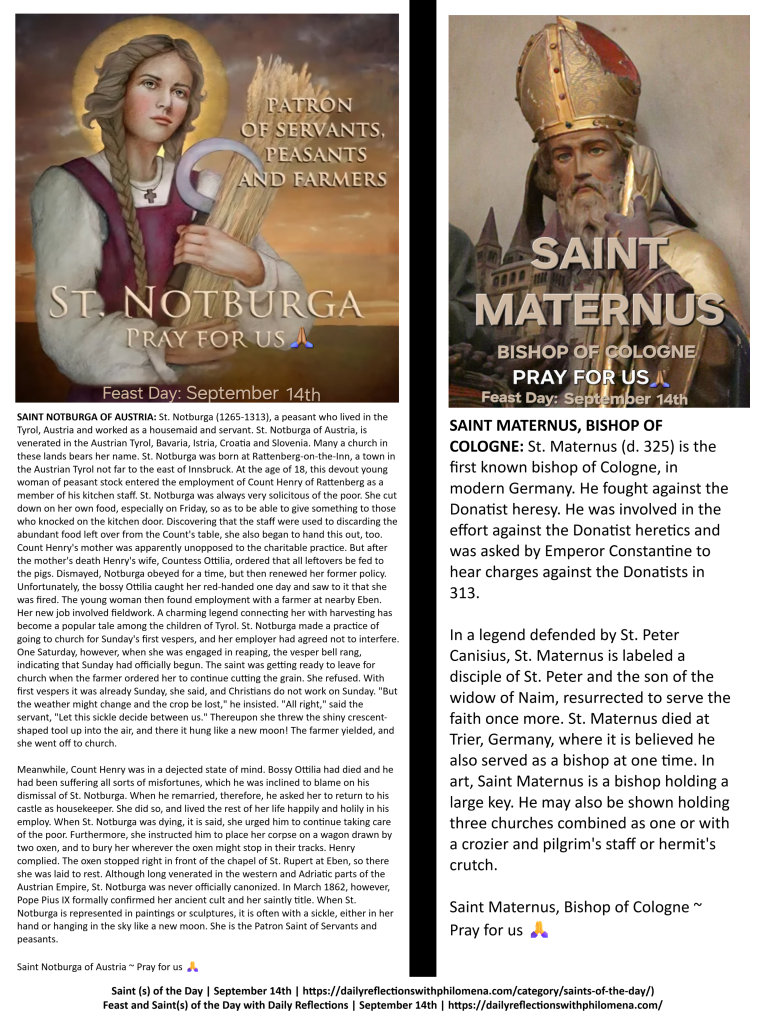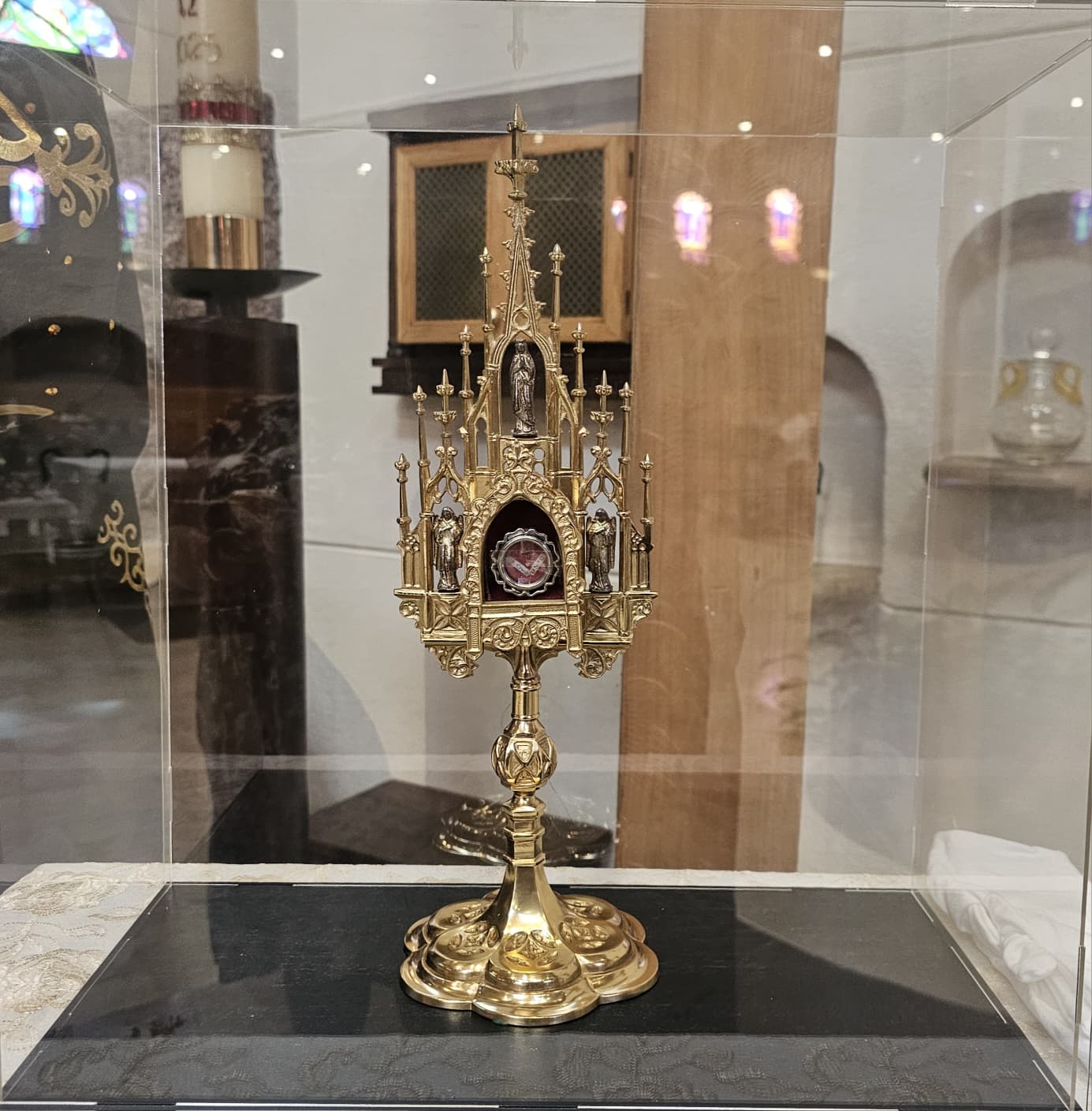RELIC OF THE TRUE CROSS OF JESUS CHRIST
(AVE CRUX, SPES UNICA)
DISPLAYED AND VENERATED AT ST. JOSEPH CATHOLIC PARISH, ARLINGTON TEXAS | SEPTEMBER 13-14, 2025
“For by Your Holy Cross You have redeemed the world”

FEAST OF THE EXALTATION OF THE HOLY CROSS OF OUR LORD JESUS CHRIST ~ FEAST DAY: SEPTEMBER 14TH: Today, we celebrate the Feast of the Exaltation of the Holy Cross of Our Lord Jesus. Through the intercession of our Blessed Mother Mary and all the Saints on this feast day, we humbly pray for the sick and dying, especially those who are mentally and physically ill, and those suffering from cancers and other terminal diseases. We pray for the souls in Purgatory and the repose of the souls of the faithful departed. We pray for the poor and the needy, and for peace, love, and unity in our marriages, our families, and our world. And we continue to pray for our Holy Father, the Bishops, the Clergy, for vocations to the priesthood and religious life, for the Church, for persecuted Christians, for the conversion of sinners, and Christians all over the world…. Amen🙏
FEAST OF THE EXALTATION OF THE HOLY CROSS: This Feast of the Exaltation of the Holy Cross celebrated on September 14th was observed in Rome before the end of the seventh century. This day is also called the Triumph of the Cross, Elevation of the Cross, Holy Cross Day, Holy Rood Day, or Roodmas. The Feast of the Exaltation of the Holy Cross celebrates two historical events: first, the discovery of the True Cross by Saint Helena, the mother of the Emperor Constantine, in 320 under the temple of Venus in Jerusalem, and secondly, the dedication in 335 of the basilica and shrine built on Calvary by Constantine, which mark the site of the Crucifixion. When the Sacred Body of Jesus was taken down from the Cross and carried to the grave on Calvary, the Cross on which He died was thrown into a ditch or well, and covered over with stones and earth, so that the followers of the Crucified Redeemer might not find it. Almost three hundred years later (312 A.D.), Constantine the Great, not yet a Christian, while battling with Maxentius for the throne of the Roman Empire, prayed to the God of the Christians to aid him in his struggle. In answer to Constantine’s prayer, a luminous cross of monogram of Christ appeared in the heavens bearing the inscription: “In This Sign You Will Conquer.” In gratitude for victory, under this banner, over Maxentius at the Milvian Bridge, on October 28, 312, Constantine had the Sign of Christianity placed on the Roman standard and on the shields of his soldiers. Then came the finding of the True Cross at Jerusalem by St. Helena in 326, commemorated by a feast on May 3. Early in the 4th century St. Helena, mother of Roman Emperor Constantine, went to Jerusalem in search of the actual locations where the events of Jesus’ life took place. She found the True Cross which immediately became an object of veneration for the Church. Constantine built a basilica on Calvary marking the site of the Crucifixion and dedicated it on this day in the year 335 A.D. The basilica was later destroyed by the Persians and the true cross was stolen. This day also marks the recovery of the cross by Emperor Heraclius II who returned it to Jerusalem, carrying it on his own back and restoring it to the Church in 629 A.D.
The basilica, named the Martyrium, and the shrine, named the Calvarium, were destroyed by the Persians in the year 614. Chosroes II, King of Persia, invaded Syria and Palestine; he took and sacked Jerusalem, carrying off with other treasures the great relic of the True Cross. The Emperor Heraclius of Constantinople, at the head of a large army, invaded Persia, and forced the Persians to sue for peace and to restore the Sacred Cross, which Heraclius piously brought back to Jerusalem in 629. The Golden Legend describes Emperor Heraclius carrying the Cross back to Jerusalem on his shoulders. He was clothed with costly garments and with ornaments of precious stones. But at the entrance to the city gate on the way that led to Mt. Calvary a strange incident occurred. Try as hard as he would, he could not go forward. Zacharias, the Bishop of Jerusalem, then said to the astonished monarch: “Consider, O Emperor, that with these triumphal ornaments you are far from resembling Jesus carrying His Cross.” The Emperor then laid aside every robe and mark of royalty, put on a penitential garb and clothed in sackcloth of penance and barefoot, continued the journey carrying the Cross up the ascent of Calvary and restored it to its place in the Church of the Holy Sepulcher. This event is commemorated by the Church on September 14, in the feast of the Exaltation of the Holy Cross. The Church of the Holy sepulcher which now stands on the site was built by the crusaders in 1149. However the feast, more than anything else, is a celebration and commemoration of God’s greatest work: his salvific death on the Cross and His Resurrection, through which death was defeated and the doors to Heaven opened.
The liturgy of the Cross is a triumphant liturgy. When Moses lifted up the bronze serpent over the people, it was a foreshadowing of the salvation through Jesus when He was lifted up on the Cross. Our Mother Church sings of the triumph of the Cross, the instrument of our redemption. To follow Christ we must take up His cross, follow Him and become obedient until death, even if it means death on the cross. We identify with Christ on the Cross and become co-redeemers, sharing in His cross. We made the Sign of the Cross before prayer which helps to fix our minds and hearts to God. After prayer we make the Sign of the Cross to keep close to God. During trials and temptations our strength and protection is the Sign of the Cross. At Baptism we are sealed with the Sign of the Cross, signifying the fullness of redemption and that we belong to Christ. Let us look to the cross frequently, and realize that when we make the Sign of the Cross we give our entire self to God — mind, soul, heart, body, will, thoughts.
O cross, you are the glorious sign of victory. Through your power may we share in the triumph of Christ Jesus.
The entrance antiphon for the Feast of the Exaltation of the Holy Cross is: “We should glory in the Cross of our Lord Jesus Christ, in whom is our salvation, life and resurrection, through whom we are saved and delivered.”
PRAYER: God, You willed that Your only Son should undergo crucifixion to bring about the salvation of the human race. Grant that we who have known His mystery on earth may deserve to reap the rewords of His redemption in heaven. Amen 🙏

SAINTS OF THE DAY: MEMORIAL OF SAINT NOTBURGA OF AUSTRIA; SAINT MATERNUS, BISHOP OF COLOGNE; SAINT PETER OF TARENTAISE, ABBOT AND SAINT ALBERT OF JERUSALEM, BISHOP ~ FEAST DAY: SEPTEMBER 14TH: Today, we also celebrate the Memorial of Saint Notburga, a peasant who lived in the Tyrol, Austria; Saint Maternus, and Bishop of Cologne.
SAINT NOTBURGA OF AUSTRIA: St. Notburga (1265-1313), a peasant who lived in the Tyrol, Austria and worked as a housemaid and servant. St. Notburga of Austria, is venerated in the Austrian Tyrol, Bavaria, Istria, Croatia and Slovenia. Many a church in these lands bears her name. St. Notburga was born at Rattenberg-on-the-Inn, a town in the Austrian Tyrol not far to the east of Innsbruck. At the age of 18, this devout young woman of peasant stock entered the employment of Count Henry of Rattenberg as a member of his kitchen staff. St. Notburga was always very solicitous of the poor. She cut down on her own food, especially on Friday, so as to be able to give something to those who knocked on the kitchen door. Discovering that the staff were used to discarding the abundant food left over from the Count’s table, she also began to hand this out, too. Count Henry’s mother was apparently unopposed to the charitable practice. But after the mother’s death Henry’s wife, Countess Ottilia, ordered that all leftovers be fed to the pigs. Dismayed, Notburga obeyed for a time, but then renewed her former policy. Unfortunately, the bossy Ottilia caught her red-handed one day and saw to it that she was fired. The young woman then found employment with a farmer at nearby Eben. Her new job involved fieldwork. A charming legend connecting her with harvesting has become a popular tale among the children of Tyrol. St. Notburga made a practice of going to church for Sunday’s first vespers, and her employer had agreed not to interfere. One Saturday, however, when she was engaged in reaping, the vesper bell rang, indicating that Sunday had officially begun. The saint was getting ready to leave for church when the farmer ordered her to continue cutting the grain. She refused. With first vespers it was already Sunday, she said, and Christians do not work on Sunday. “But the weather might change and the crop be lost,” he insisted. “All right,” said the servant, “Let this sickle decide between us.” Thereupon she threw the shiny crescent-shaped tool up into the air, and there it hung like a new moon! The farmer yielded, and she went off to church.
Meanwhile, Count Henry was in a dejected state of mind. Bossy Ottilia had died and he had been suffering all sorts of misfortunes, which he was inclined to blame on his dismissal of St. Notburga. When he remarried, therefore, he asked her to return to his castle as housekeeper. She did so, and lived the rest of her life happily and holily in his employ. When St. Notburga was dying, it is said, she urged him to continue taking care of the poor. Furthermore, she instructed him to place her corpse on a wagon drawn by two oxen, and to bury her wherever the oxen might stop in their tracks. Henry complied. The oxen stopped right in front of the chapel of St. Rupert at Eben, so there she was laid to rest. Although long venerated in the western and Adriatic parts of the Austrian Empire, St. Notburga was never officially canonized. In March 1862, however, Pope Pius IX formally confirmed her ancient cult and her saintly title. When St. Notburga is represented in paintings or sculptures, it is often with a sickle, either in her hand or hanging in the sky like a new moon. She is the Patron Saint of Servants and peasants.
Saint Notburga of Austria ~ Pray for us 🙏
SAINT MATERNUS, BISHOP OF COLOGNE: St. Maternus (d. 325) is the first known bishop of Cologne, in modern Germany. He fought against the Donatist heresy. He was involved in the effort against the Donatist heretics and was asked by Emperor Constantine to hear charges against the Donatists in 313.
In a legend defended by St. Peter Canisius, St. Maternus is labeled a disciple of St. Peter and the son of the widow of Naim, resurrected to serve the faith once more. St. Maternus died at Trier, Germany, where it is believed he also served as a bishop at one time. In art, Saint Maternus is a bishop holding a large key. He may also be shown holding three churches combined as one or with a crozier and pilgrim’s staff or hermit’s crutch.
Saint Maternus, Bishop of Cologne ~ Pray for us 🙏
